Funai SV2000 CWV20V6 User Manual
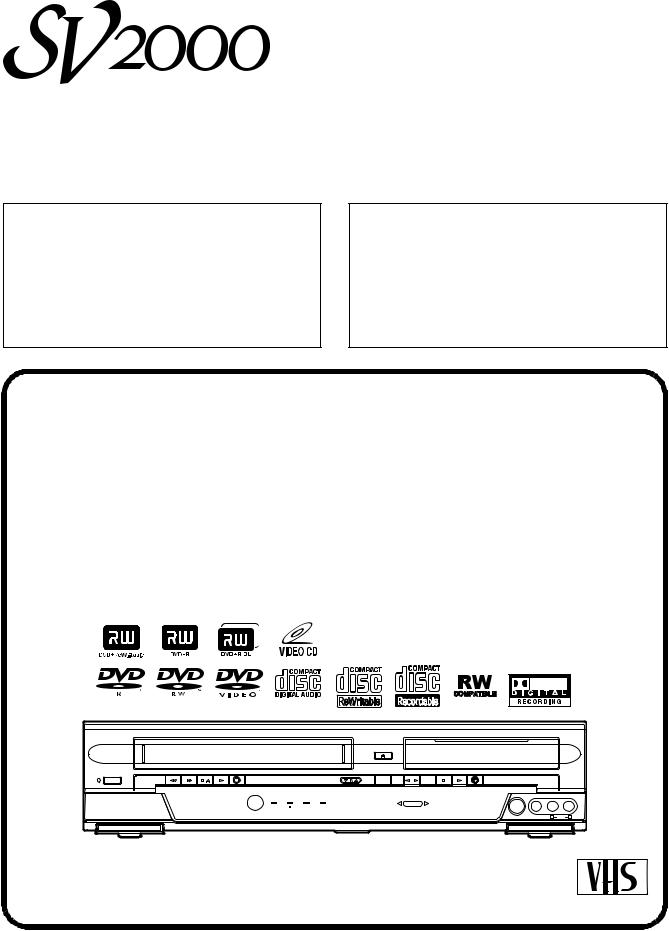
SERVICE MANUAL
Main Section
ISpecifications
IPreparation for Servicing
IAdjustment Procedures
ISchematic Diagrams
ICBA’s
IExploded Views
IParts List
When servicing the deck mechanism, refer to MK14 Deck Mechanism Section.
Deck Mechanism Part No.:
N2460FL
DVD RECORDER &
VIDEO CASSETTE RECORDER
CWV20V6
|
|
|
|
|
OPEN/CLOSE |
|
|
|
|
STANDBY-ON |
REW |
F.FWD STOP/EJECT PLAY |
RECORD |
CHANNEL |
D.DUBBING |
SELECT |
STOP |
PLAY |
RECORD |
|
|
|
VCR REC D.DUBBING TIMER REC |
DVD REC |
|
|
|
|
|
|
|
|
VCR DVD |
|
VCR |
SOURCE |
DVD |
|
|
|
|
|
|
|
|
|
|
|
S-VIDEO |
VIDEO |
L AUDIO R |

IMPORTANT SAFETY NOTICE
Proper service and repair is important to the safe, reliable operation of all Funai Equipment. The service procedures recommended by Funai and described in this service manual are effective methods of performing service operations. Some of these service special tools should be used when and as recommended.
It is important to note that this service manual contains various CAUTIONS and NOTICES which should be carefully read in order to minimize the risk of personal injury to service personnel. The possibility exists that improper service methods may damage the equipment. It also is important to understand that these CAUTIONS and NOTICES ARE NOT EXHAUSTIVE. Funai could not possibly know, evaluate and advice the service trade of all conceivable ways in which service might be done or of the possible hazardous consequences of each way. Consequently, Funai has not undertaken any such broad evaluation. Accordingly, a servicer who uses a service procedure or tool which is not recommended by Funai must first use all precautions thoroughly so that neither his safety nor the safe operation of the equipment will be jeopardized by the service method selected.
Manufactured under license from Dolby Laboratories.
“Dolby” and the double-D symbol are trademarks of Dolby Laboratories.

MAIN SECTION
DVD RECORDER &
VIDEO CASSETTE RECORDER
CWV20V6
Main Section
ISpecifications
IPreparation for Servicing
IAdjustment Procedures
ISchematic Diagrams
ICBA’s
IExploded Views
IParts List
TABLE OF CONTENTS
Specifications . . . . . . . . . . . . . . . . . . . . . . . . . . . . . . . . . . . . . . . . . . . . . . . . . . . . . . . . . . . . . . . . . . . . . . . . . . 1-1-1 Laser Beam Safety Precautions . . . . . . . . . . . . . . . . . . . . . . . . . . . . . . . . . . . . . . . . . . . . . . . . . . . . . . . . . . . . 1-2-1 Important Safety Precautions . . . . . . . . . . . . . . . . . . . . . . . . . . . . . . . . . . . . . . . . . . . . . . . . . . . . . . . . . . . . . . 1-3-1 Standard Notes for Servicing . . . . . . . . . . . . . . . . . . . . . . . . . . . . . . . . . . . . . . . . . . . . . . . . . . . . . . . . . . . . . . 1-4-1 Preparation for Servicing. . . . . . . . . . . . . . . . . . . . . . . . . . . . . . . . . . . . . . . . . . . . . . . . . . . . . . . . . . . . . . . . . . 1-5-1 Cabinet Disassembly Instructions . . . . . . . . . . . . . . . . . . . . . . . . . . . . . . . . . . . . . . . . . . . . . . . . . . . . . . . . . . . 1-6-1 Electrical Adjustment Instructions . . . . . . . . . . . . . . . . . . . . . . . . . . . . . . . . . . . . . . . . . . . . . . . . . . . . . . . . . . . 1-7-1 How to Initialize the DVD Recorder & VCR . . . . . . . . . . . . . . . . . . . . . . . . . . . . . . . . . . . . . . . . . . . . . . . . . . . . 1-8-1 Firmware Renewal Mode . . . . . . . . . . . . . . . . . . . . . . . . . . . . . . . . . . . . . . . . . . . . . . . . . . . . . . . . . . . . . . . . . 1-9-1 Function Indicator Symbols. . . . . . . . . . . . . . . . . . . . . . . . . . . . . . . . . . . . . . . . . . . . . . . . . . . . . . . . . . . . . . . 1-10-1 Block Diagrams . . . . . . . . . . . . . . . . . . . . . . . . . . . . . . . . . . . . . . . . . . . . . . . . . . . . . . . . . . . . . . . . . . . . . . . . 1-11-1 Schematic Diagrams / CBA’s and Test Points. . . . . . . . . . . . . . . . . . . . . . . . . . . . . . . . . . . . . . . . . . . . . . . . . 1-12-1 Waveforms . . . . . . . . . . . . . . . . . . . . . . . . . . . . . . . . . . . . . . . . . . . . . . . . . . . . . . . . . . . . . . . . . . . . . . . . . . . 1-13-1 Wiring Diagram < VCR Section > . . . . . . . . . . . . . . . . . . . . . . . . . . . . . . . . . . . . . . . . . . . . . . . . . . . . . . . . . . 1-14-1 Wiring Diagram < DVD Section > . . . . . . . . . . . . . . . . . . . . . . . . . . . . . . . . . . . . . . . . . . . . . . . . . . . . . . . . . . 1-14-2 System Control Timing Charts . . . . . . . . . . . . . . . . . . . . . . . . . . . . . . . . . . . . . . . . . . . . . . . . . . . . . . . . . . . . 1-15-1 IC Pin Function Descriptions. . . . . . . . . . . . . . . . . . . . . . . . . . . . . . . . . . . . . . . . . . . . . . . . . . . . . . . . . . . . . . 1-16-1 Lead Identifications . . . . . . . . . . . . . . . . . . . . . . . . . . . . . . . . . . . . . . . . . . . . . . . . . . . . . . . . . . . . . . . . . . . . . 1-17-1 Exploded Views. . . . . . . . . . . . . . . . . . . . . . . . . . . . . . . . . . . . . . . . . . . . . . . . . . . . . . . . . . . . . . . . . . . . . . . . 1-18-1 Mechanical Parts List . . . . . . . . . . . . . . . . . . . . . . . . . . . . . . . . . . . . . . . . . . . . . . . . . . . . . . . . . . . . . . . . . . . 1-19-1 Electrical Parts List . . . . . . . . . . . . . . . . . . . . . . . . . . . . . . . . . . . . . . . . . . . . . . . . . . . . . . . . . . . . . . . . . . . . . 1-20-1
SPECIFICATIONS
< VCR Section >
Description |
Unit |
Minimum |
Nominal |
Maximum |
Remark |
|
|
|
|
|
|
|
|
|
|
|
|
1. Video |
|
|
|
|
|
|
|
|
|
|
|
1-1. Video Output (PB) |
Vp-p |
0.8 |
1.0 |
1.2 |
SP Mode |
|
|
|
|
|
|
1-2. Video Output (R/P) |
Vp-p |
0.8 |
1.0 |
1.2 |
|
|
|
|
|
|
|
1-3. Video S/N Y (R/P) |
dB |
40 |
45 |
|
SP Mode, |
|
W/O Burst |
||||
|
|
|
|
|
|
|
|
|
|
|
|
1-4. Video Color S/N AM (R/P) |
dB |
37 |
41 |
|
SP Mode |
|
|
|
|
|
|
1-5. Video Color S/N PM (R/P) |
dB |
30 |
36 |
|
SP Mode |
|
|
|
|
|
|
1-6. Resolution (PB) |
Line |
230 |
245 |
|
SP Mode |
|
|
|
|
|
|
2. Servo |
|
|
|
|
|
|
|
|
|
|
|
2-1. Jitter Low |
sec |
|
0.07 |
0.12 |
SP Mode |
|
|
|
|
|
|
2-2. Wow & Flutter |
% |
|
0.3 |
0.5 |
SP Mode |
|
|
|
|
|
|
3. Normal Audio |
|
|
|
|
|
|
|
|
|
|
|
3-1. Output (PB) |
dBV |
-9 |
-6 |
-3 |
SP Mode |
|
|
|
|
|
|
3-2. Output (R/P) |
dBV |
-9 |
-6 |
-1.5 |
SP Mode |
|
|
|
|
|
|
3-3. S/N (R/P) |
dB |
36 |
41 |
|
SP Mode |
|
|
|
|
|
|
3-4. Distortion (R/P) |
% |
|
1.0 |
4.0 |
SP Mode |
|
|
|
|
|
|
3-5. Freq. resp (R/P) at 200Hz |
dB |
-11 |
-4 |
|
SP Mode |
|
|
|
|
|
|
(-20dB ref. 1kHz) at 8kHz |
dB |
-14 |
-4 |
|
SP Mode |
|
|
|
|
|
|
4. Tuner |
|
|
|
|
|
|
|
|
|
|
|
4-1. Video output |
Vp-p |
0.8 |
1.0 |
1.2 |
E-E Mode |
|
|
|
|
|
|
4-2. Video S/N |
dB |
39 |
42 |
|
E-E Mode |
|
|
|
|
|
|
4-3. Audio output |
dB |
-10 |
-6 |
-2 |
E-E Mode |
|
|
|
|
|
|
4-4. Audio S/N |
dB |
40 |
46 |
|
E-E Mode |
|
|
|
|
|
|
5. Hi-Fi Audio |
|
|
|
|
|
|
|
|
|
|
|
5-1. Output |
dBV |
-12 |
-8 |
-4 |
SP Mode |
|
|
|
|
|
|
5-2. Dynamic Range |
dB |
70 |
85 |
|
SP Mode |
|
|
|
|
|
|
5-3. Freq. resp (6dB B.W) |
Hz |
|
20 ~ 20K |
|
SP Mode |
|
|
|
|
|
|
Note: Nominal specs represent the design specs. All units should be able to approximate these – some will exceed and some may drop slightly below these specs. Limit specs represent the absolute worst condition that still might be considered acceptable; In no case should a unit fail to meet limit specs.
1-1-1 |
E9400SP |
< DVD Section >
ITEM |
CONDITIONS |
UNIT |
NOMINAL |
LIMIT |
|
|
|
|
|
|
|
|
|
|
1. VIDEO |
|
|
|
|
|
|
|
|
|
1-1. Video Output |
75 ohm load |
Vp-p |
1.0 |
|
|
|
|
|
|
1-2. S-Video Output |
|
|
|
|
|
|
|
|
|
Y (Luminance) |
75 ohm load |
Vp-p |
1.0 |
|
|
|
|
|
|
C (Chrominance) |
75 ohm load |
Vp-p |
0.286 |
|
|
|
|
|
|
1-3. Component Output |
|
|
|
|
|
|
|
|
|
Y (Luminance) |
75 ohm load |
Vp-p |
1.0 |
|
|
|
|
|
|
Cb (Chrominance) |
75 ohm load |
Vp-p |
0.7 |
|
|
|
|
|
|
Cr (Chrominance) |
75 ohm load |
Vp-p |
0.7 |
|
|
|
|
|
|
2. AUDIO |
|
|
|
|
|
|
|
|
|
2-1. Output Level |
|
Vrms |
2.0 |
|
|
|
|
|
|
2-2. Frequency Response |
|
|
|
|
|
|
|
|
|
DVD-VIDEO LPCM |
fs = 48kHz 20~22kHz |
dB |
± 0.5 |
|
|
|
|
|
|
Audio CD |
fs = 44.1kHz 20~20 kHz |
dB |
± 0.5 |
|
|
|
|
|
|
2-3. Signal/Noise Ratio |
|
|
|
|
|
|
|
|
|
DVD-VIDEO LPCM |
|
dB |
90 |
|
|
|
|
|
|
CD |
|
dB |
90 |
|
|
|
|
|
|
REC & Playback |
Input: 2 Vrms, Rec Speed: XP |
dB |
80 |
|
|
|
|
|
|
2-4. Dynamic Range |
|
|
|
|
|
|
|
|
|
DVD-VIDEO LPCM |
|
dB |
80 |
|
|
|
|
|
|
CD |
|
dB |
80 |
|
|
|
|
|
|
REC & Playback |
Input: 2 Vrms, Rec Speed: XP |
dB |
80 |
|
|
|
|
|
|
2-5. THD+N |
1 kHz, 0 dB |
|
|
|
|
|
|
|
|
DVD-VIDEO LPCM |
|
% |
0.01 |
|
|
|
|
|
|
CD |
|
% |
0.01 |
|
|
|
|
|
|
REC & Playback |
Input: 2 Vrms, Rec Speed: XP |
% |
0.01 |
|
|
|
|
|
|
NOTES:
1.All Items are measured without pre-emphasis unless otherwise specified.
2.Power supply : AC120 V 60 Hz
4. Ambient temperature : 5 °C ~ 40 °C
1-1-2 |
E9400SP |
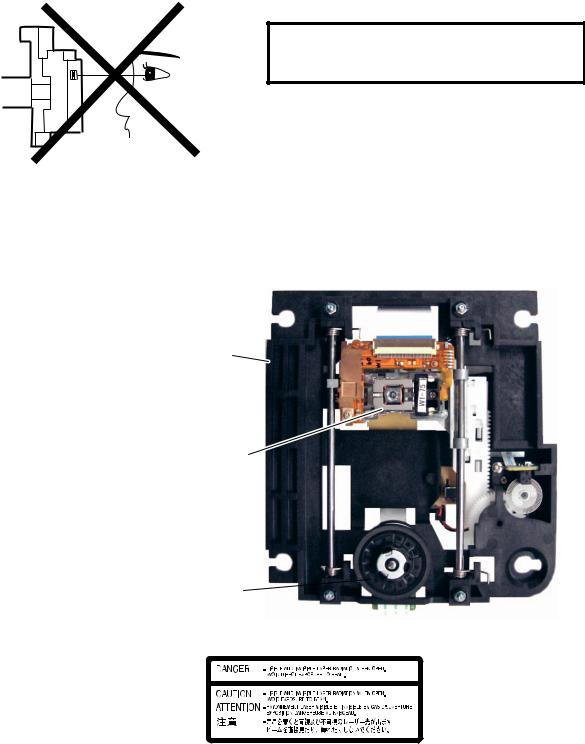
LASER BEAM SAFETY PRECAUTIONS
This DVD player uses a pickup that emits a laser beam.
Do not look directly at the laser beam coming from the pickup or allow it to strike against your skin.
The laser beam is emitted from the location shown in the figure. When checking the laser diode, be sure to keep your eyes at least 30 cm away from the pickup lens when the diode is turned on. Do not look directly at the laser beam.
CAUTION: Use of controls and adjustments, or doing procedures other than those specified herein, may result in hazardous radiation exposure.
Drive Mechanism Assembly
Laser Beam Radiation 
Laser Pickup
Turntable 
Location: Inside Top of DVD mechanism.
1-2-1 |
R3NLSP |
IMPORTANT SAFETY PRECAUTIONS
Product Safety Notice
Some electrical and mechanical parts have special safety-related characteristics which are often not evident from visual inspection, nor can the protection they give necessarily be obtained by replacing them with components rated for higher voltage, wattage, etc. Parts that have special safety characteristics are identified by a # on schematics and in parts lists. Use of a substitute replacement that does not have the same safety characteristics as the recommended replacement part might create shock, fire, and/or other hazards. The Product’s Safety is under review continuously and new instructions are issued whenever appropriate. Prior to shipment from the factory, our products are carefully inspected to confirm with the recognized product safety and electrical codes of the countries in which they are to be sold. However, in order to maintain such compliance, it is equally important to implement the following precautions when a set is being serviced.
Precautions during Servicing
A.Parts identified by the # symbol are critical for safety. Replace only with part number specified.
B.In addition to safety, other parts and assemblies are specified for conformance with regulations applying to spurious radiation. These must also be replaced only with specified replacements. Examples: RF converters, RF cables, noise blocking capacitors, and noise blocking filters, etc.
C.Use specified internal wiring. Note especially:
1)Wires covered with PVC tubing
2)Double insulated wires
3)High voltage leads
D.Use specified insulating materials for hazardous live parts. Note especially:
1)Insulation tape
2)PVC tubing
3)Spacers
4)Insulators for transistors
E.When replacing AC primary side components (transformers, power cord, etc.), wrap ends of wires securely about the terminals before soldering.
F.Observe that the wires do not contact heat producing parts (heat sinks, oxide metal film resistors, fusible resistors, etc.).
G.Check that replaced wires do not contact sharp edges or pointed parts.
H.When a power cord has been replaced, check that 5 - 6 kg of force in any direction will not loosen it.
I.Also check areas surrounding repaired locations.
J.Be careful that foreign objects (screws, solder droplets, etc.) do not remain inside the set.
K.Crimp type wire connector
The power transformer uses crimp type connectors which connect the power cord and the primary side of the transformer. When replacing the transformer, follow these steps carefully and precisely to prevent shock hazards.
Replacement procedure
1)Remove the old connector by cutting the wires at a point close to the connector.
Important: Do not re-use a connector. (Discard it.)
2)Strip about 15 mm of the insulation from the ends of the wires. If the wires are stranded, twist the strands to avoid frayed conductors.
3)Align the lengths of the wires to be connected. Insert the wires fully into the connector.
4)Use a crimping tool to crimp the metal sleeve at its center. Be sure to crimp fully to the complete closure of the tool.
L.When connecting or disconnecting the internal connectors, first, disconnect the AC plug from the AC outlet.
1-3-1 |
DVDN_ISP |
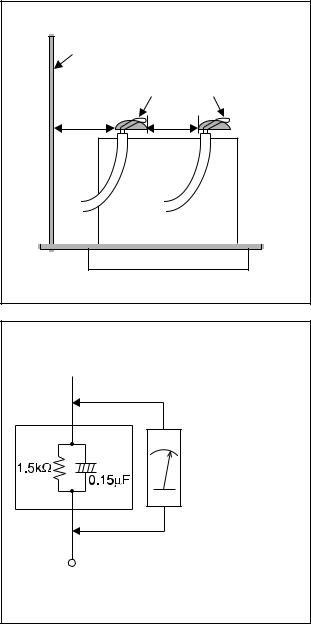
Safety Check after Servicing
Examine the area surrounding the repaired location for damage or deterioration. Observe that screws, parts, and wires have been returned to their original positions. Afterwards, do the following tests and confirm the specified values to verify compliance with safety standards.
1. Clearance Distance
When replacing primary circuit components, confirm specified clearance distance (d) and (d’) between soldered terminals, and between terminals and surrounding metallic parts. (See Fig. 1)
Table 1: Ratings for selected area
AC Line Voltage |
Clearance Distance (d), (d’) |
|
|
|
|
120 V |
≥ 3.2 mm (0.126 inches) |
|
|
Note: This table is unofficial and for reference only. Be sure to confirm the precise values.
Chassis or Secondary Conductor |
|
|
Primary Circuit |
d' |
d |
Fig. 1
2. Leakage Current Test
Confirm the specified (or lower) leakage current between B (earth ground, power cord plug prongs) and externally exposed accessible parts (RF terminals, antenna terminals, video and audio input and output terminals, microphone jacks, earphone jacks, etc.) is lower than or equal to the specified value in the table below.
Measuring Method (Power ON):
Insert load Z between B (earth ground, power cord plug prongs) and exposed accessible parts. Use an AC voltmeter to measure across the terminals of load Z. See Fig. 2 and the following table.
Table 2: Leakage current ratings for selected areas
 Exposed Accessible Part
Exposed Accessible Part
Z
AC Voltmeter
(High Impedance)
BEarth Ground
Power Cord Plug Prongs
Fig. 2
AC Line Voltage |
Load Z |
Leakage Current (i) |
Earth Ground (B) to: |
|
|
|
|
|
|
|
|
|
|
|
120 V |
0.15 µF CAP. & 1.5 kΩ RES. |
i ≤ 0.5 mA Peak |
Exposed accessible parts |
|
Connected in parallel |
||||
|
|
|
||
|
|
|
|
|
Note: This table is unofficial and for reference only. Be sure to confirm the precise values. |
||||
1-3-2 |
DVDN_ISP |
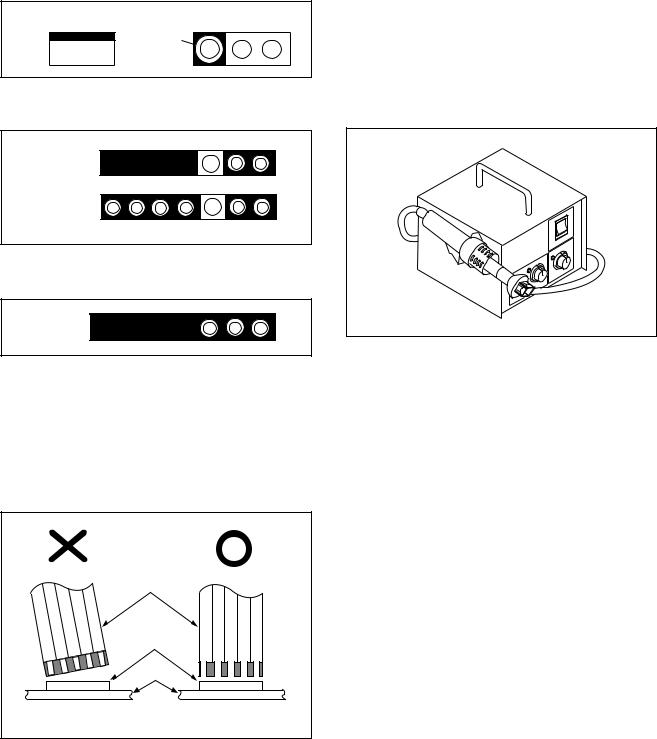
STANDARD NOTES FOR SERVICING
Circuit Board Indications
1.The output pin of the 3 pin Regulator ICs is indicated as shown.
Top View |
Bottom View |
Out |
Input |
In |
2.For other ICs, pin 1 and every fifth pin are indicated as shown.
5
Pin 1 






10
3.The 1st pin of every male connector is indicated as shown.
Pin 1 




Instructions for Connectors
1.When you connect or disconnect the FFC (Flexible Foil Connector) cable, be sure to first disconnect the AC cord.
2.FFC (Flexible Foil Connector) cable should be inserted parallel into the connector, not at an angle.
FFC Cable
Connector
CBA
Pb (Lead) Free Solder
When soldering, be sure to use the Pb free solder.
How to Remove / Install Flat Pack-IC
1. Removal
With Hot-Air Flat Pack-IC Desoldering Machine:
1.Prepare the hot-air flat pack-IC desoldering machine, then apply hot air to the Flat Pack-IC (about 5 to 6 seconds). (Fig. S-1-1)
Fig. S-1-1
2.Remove the flat pack-IC with tweezers while applying the hot air.
3.Bottom of the flat pack-IC is fixed with glue to the CBA; when removing entire flat pack-IC, first apply soldering iron to center of the flat pack-IC and heat up. Then remove (glue will be melted). (Fig. S-1-6)
4.Release the flat pack-IC from the CBA using tweezers. (Fig. S-1-6)
CAUTION:
1.The Flat Pack-IC shape may differ by models. Use an appropriate hot-air flat pack-IC desoldering machine, whose shape matches that of the Flat Pack-IC.
2.Do not supply hot air to the chip parts around the flat pack-IC for over 6 seconds because damage to the chip parts may occur. Put masking tape around the flat pack-IC to protect other parts from damage. (Fig. S-1-2)
* Be careful to avoid a short circuit.
1-4-1 |
DVDN_SN |
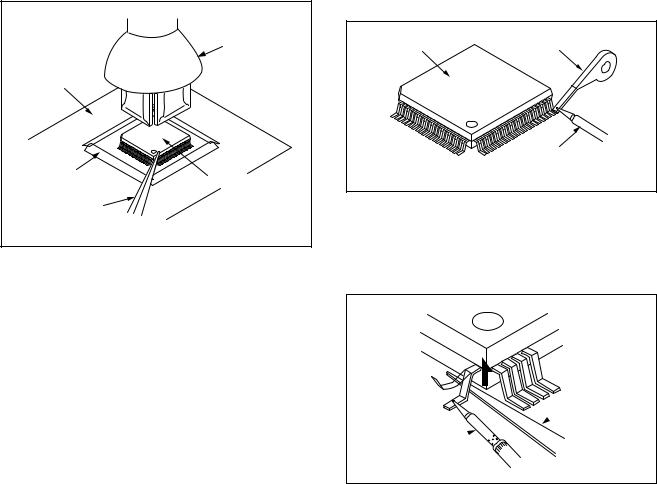
3.The flat pack-IC on the CBA is affixed with glue, so be careful not to break or damage the foil of each pin or the solder lands under the IC when removing it.
|
Hot-air |
|
Flat Pack-IC |
|
Desoldering |
CBA |
Machine |
|
|
Masking |
Flat Pack-IC |
Tape |
|
Tweezers |
|
|
Fig. S-1-2 |
With Soldering Iron:
1.Using desoldering braid, remove the solder from all pins of the flat pack-IC. When you use solder flux which is applied to all pins of the flat pack-IC, you can remove it easily. (Fig. S-1-3)
Flat Pack-IC |
Desoldering Braid |
|
Soldering Iron
Fig. S-1-3
2.Lift each lead of the flat pack-IC upward one by one, using a sharp pin or wire to which solder will not adhere (iron wire). When heating the pins, use a fine tip soldering iron or a hot air desoldering machine. (Fig. S-1-4)
Sharp
 Pin
Pin
Fine Tip 
Soldering Iron
Fig. S-1-4
3.Bottom of the flat pack-IC is fixed with glue to the CBA; when removing entire flat pack-IC, first apply soldering iron to center of the flat pack-IC and heat up. Then remove (glue will be melted). (Fig. S-1-6)
4.Release the flat pack-IC from the CBA using tweezers. (Fig. S-1-6)
1-4-2 |
DVDN_SN |
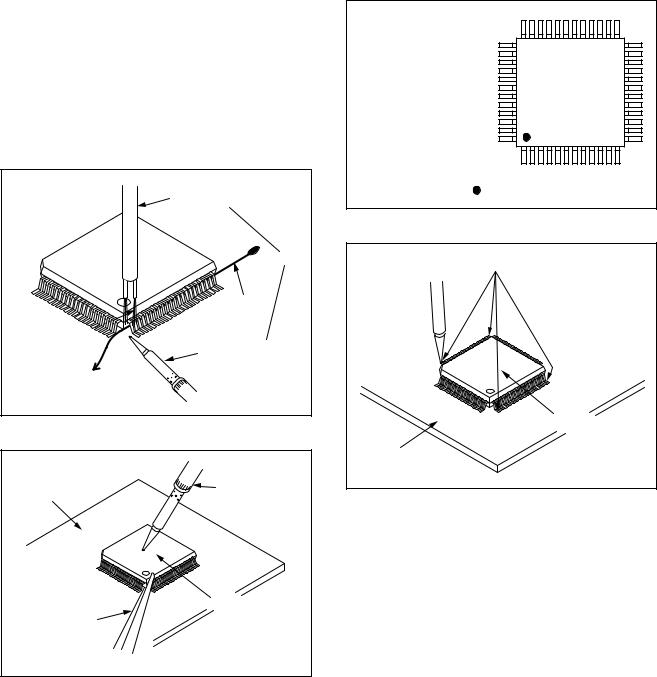
With Iron Wire:
1.Using desoldering braid, remove the solder from all pins of the flat pack-IC. When you use solder flux which is applied to all pins of the flat pack-IC, you can remove it easily. (Fig. S-1-3)
2.Affix the wire to a workbench or solid mounting point, as shown in Fig. S-1-5.
3.While heating the pins using a fine tip soldering iron or hot air blower, pull up the wire as the solder melts so as to lift the IC leads from the CBA contact pads as shown in Fig. S-1-5.
4.Bottom of the flat pack-IC is fixed with glue to the CBA; when removing entire flat pack-IC, first apply soldering iron to center of the flat pack-IC and heat up. Then remove (glue will be melted). (Fig. S-1-6)
5.Release the flat pack-IC from the CBA using tweezers. (Fig. S-1-6)
Note: When using a soldering iron, care must be taken to ensure that the flat pack-IC is not being held by glue. When the flat pack-IC is removed from the CBA, handle it gently because it may be damaged if force is applied.
Hot Air Blower |
or |
Iron Wire |
Soldering Iron |
To Solid |
Mounting Point |
Fig. S-1-5 |
CBA |
Fine Tip |
Soldering Iron |
|
|
Flat Pack-IC |
Tweezers |
|
|
Fig. S-1-6 |
2. Installation
1.Using desoldering braid, remove the solder from the foil of each pin of the flat pack-IC on the CBA so you can install a replacement flat pack-IC more easily.
2.The “●” mark on the flat pack-IC indicates pin 1. (See Fig. S-1-7.) Be sure this mark matches the 1 on the PCB when positioning for installation. Then presolder the four corners of the flat pack-IC. (See Fig. S-1-8.)
3.Solder all pins of the flat pack-IC. Be sure that none of the pins have solder bridges.
Example :
Pin 1 of the Flat Pack-IC |
|
is indicated by a " " mark. |
Fig. S-1-7 |
|
Presolder |
Flat Pack-IC |
CBA |
Fig. S-1-8 |
1-4-3 |
DVDN_SN |
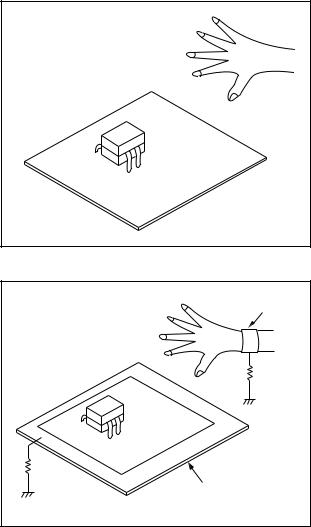
Instructions for Handling Semiconductors
Electrostatic breakdown of the semi-conductors may occur due to a potential difference caused by electrostatic charge during unpacking or repair work.
1. Ground for Human Body
Be sure to wear a grounding band (1 MΩ) that is properly grounded to remove any static electricity that may be charged on the body.
2. Ground for Workbench
Be sure to place a conductive sheet or copper plate with proper grounding (1 MΩ) on the workbench or other surface, where the semi-conductors are to be placed. Because the static electricity charge on clothing will not escape through the body grounding band, be careful to avoid contacting semi-conductors with your clothing.
<Incorrect> |
|
|
CBA |
<Correct> |
Grounding Band |
|
1MΩ |
|
CBA |
1MΩ |
|
Conductive Sheet or
Copper Plate
1-4-4 |
DVDN_SN |
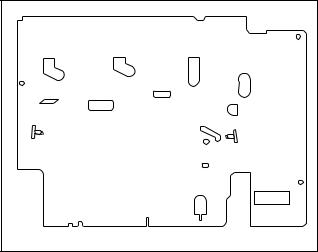
PREPARATION FOR SERVICING
How to Enter the Service Mode
About Optical Sensors
Caution:
An optical sensor system is used for the Tape Start and End Sensors on this equipment. Carefully read and follow the instructions below. Otherwise the unit may operate erratically.
What to do for preparation
Insert a tape into the Deck Mechanism Assembly and press the PLAY button. The tape will be loaded into the Deck Mechanism Assembly. Make sure the power is on, connect TP502 (S-INH) to GND. This will stop the function of Tape Start Sensor, Tape End Sensor and Reel Sensors. (If these TPs are connected before plugging in the unit, the function of the sensors will stay valid.) See Fig. 1.
Q503 |
Q504 |
TP502 |
S-INH |
Fig. 1 |
Note: Because the Tape End Sensors are inactive, do not run a tape all the way to the start or the end of the tape to avoid tape damage.
1-5-1 |
E9A80PFS |
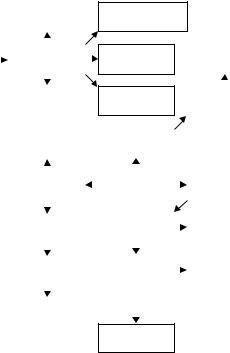
CABINET DISASSEMBLY INSTRUCTIONS
1. Disassembly Flowchart
This flowchart indicates the disassembly steps to gain access to item(s) to be serviced. When reassembling, follow the steps in reverse order. Bend, route, and dress the cables as they were originally.
|
|
[17] Power |
|
[18] DVD Open |
|
|
||||||
|
|
SW CBA |
|
/Close SW CBA |
|
|
||||||
|
|
|
|
|
|
|
|
|
|
|
|
|
|
|
|
|
|
|
|
[16] Deck |
|
|
|||
|
|
|
|
|
|
|
|
|
||||
|
|
[15] VCR |
|
[6] Jack CBA |
||||||||
|
|
Chassis Unit |
|
|
|
Assembly |
||||||
|
|
|
|
|
||||||||
|
|
|
|
|
|
|
|
|
|
|
|
|
|
|
|
|
|
|
|
|
|
|
|
|
|
|
|
|
|
|
|
|
|
|
|
|
|
|
|
|
[19] Main |
|
[20] Deck |
[5] Jack |
|||||||
|
|
CBA |
|
Pedestal |
Bracket |
|||||||
|
|
|
|
|
|
|
|
|
|
|
|
|
|
|
|
|
|
|
|
|
|
|
|
|
|
|
|
[11] DC |
|
|
|
[2] Front |
|
|
|
|
||
|
|
Fan Motor |
|
|
|
Assembly |
|
|
|
|
||
|
|
|
|
|
|
|
|
|
|
|
|
|
|
|
|
|
|
|
|
|
|
|
|
|
|
|
|
|
|
|
|
|
|
|
|
|
|
|
|
|
[9] Rear |
|
|
|
[1] Top Cover |
|
|
[3] Front |
|||
|
|
Panel Unit |
|
|
|
|
|
Bracket |
||||
|
|
|
|
|
|
|
|
|
||||
|
|
|
|
|
|
|
|
|
|
|
|
|
|
|
|
|
|
|
|
|
|
|
|
|
|
|
|
[10] Power |
|
|
|
[4] Radiation |
|
|
[21] Front |
|||
|
|
Supply CBA |
|
|
|
Sheet |
|
|
Bracket R |
|||
|
|
|
|
|
|
|
|
|
|
|
|
|
|
|
|
|
|
|
|
|
|
|
|
|
|
|
|
[12] PCB |
|
|
|
[7] DVD |
|
|
[8] Dust Cover |
|||
|
|
Holder |
|
|
|
Mechanism |
|
|
||||
|
|
|
|
|
|
|
|
|
||||
|
|
|
|
|
|
|
& DVD Main |
|
|
|
|
|
|
|
|
|
|
|
|
|
|
|
|
||
|
|
|
|
|
|
|
|
|
|
|
||
|
|
[13] Rear |
|
|
|
CBA Assembly |
|
|
|
|
||
|
|
|
|
|
|
|
|
|
|
|
||
|
|
Panel |
|
|
|
|
|
|
|
|
|
|
|
|
|
|
|
|
|
|
|
|
|
||
|
|
|
|
|
|
|
|
|
|
|
|
|
[14]Bracket R
2.Disassembly Method
ID/ |
|
|
REMOVAL |
|
|
|
|
|
|
||
|
|
REMOVE/*UNHOOK/ |
|
||
LOC. |
PART |
Fig. |
|
||
UNLOCK/RELEASE/ |
Note |
||||
No. |
|
||||
|
No. |
UNPLUG/DESOLDER |
|
||
|
|
|
|||
|
|
|
|
|
|
|
|
|
|
|
|
[1] |
Top Cover |
D1 |
6(S-1) |
--- |
|
|
|
|
|
|
|
|
Front |
|
*5(L-1), *3(L-2), |
1 |
|
[2] |
D2 |
1-1 |
|||
Assembly |
*CN1609 |
1-2 |
|||
|
|
||||
|
|
|
|
1-3 |
|
|
|
|
|
|
|
[3] |
Front |
D2 |
2(S-2), (S-3) |
--- |
|
Bracket |
|||||
|
|
|
|
||
|
|
|
|
|
|
[4] |
Radiation |
D2 |
---------- |
--- |
|
Sheet |
|||||
|
|
|
|
||
|
|
|
|
|
|
[5] |
Jack |
D3 |
2(S-4) |
--- |
|
Bracket |
|||||
|
|
|
|
||
|
|
|
|
|
|
[6] |
Jack CBA |
D3 |
Jack Earth Plate |
--- |
|
|
|
|
|
|
|
|
DVD |
|
|
|
|
|
Mechanism |
|
2(S-5A), 2(S-5B), |
|
|
[7] |
& DVD |
D4 |
--- |
||
*CN101, *CN701 |
|||||
|
Main CBA |
|
|
||
|
|
|
|
||
|
Assembly |
|
|
|
|
|
|
|
|
|
|
[8] |
Dust Cover |
D4 |
---------- |
--- |
|
|
|
|
|
|
ID/ |
|
|
REMOVAL |
|
|
|
|
|
|
||
|
|
REMOVE/*UNHOOK/ |
|
||
LOC. |
PART |
Fig. |
|
||
UNLOCK/RELEASE/ |
Note |
||||
No. |
|
||||
|
No. |
UNPLUG/DESOLDER |
|
||
|
|
|
|||
|
|
|
|
|
|
|
|
|
|
|
|
[9] |
Rear Panel |
D5 |
6(S-6), 3(S-7), (S-8), |
--- |
|
Unit |
*CN101, *CN102 |
||||
|
|
|
|||
|
|
|
|
|
|
|
Power |
|
|
|
|
[10] |
Supply |
D6 |
4(S-9), AC Cord |
--- |
|
|
CBA |
|
|
|
|
|
|
|
|
|
|
[11] |
DC Fan |
D6 |
2(S-10), Earth Plate |
--- |
|
Motor |
|||||
|
|
|
|
|
|
[12] |
PCB |
D6 |
3(S-11) |
--- |
|
Holder |
|||||
|
|
|
|
|
|
[13] |
Rear Panel |
D6 |
---------- |
--- |
|
|
|
|
|
|
|
[14] |
Bracket R |
D7 |
2(S-12) |
--- |
|
|
|
|
|
|
|
|
VCR |
|
5(S-13), 6(S-14), |
|
|
[15] |
Chassis |
D7 |
--- |
||
(S-15), (S-16) |
|||||
|
Unit |
|
|
||
|
|
|
|
||
|
|
|
|
|
|
[16] |
Deck |
D8 |
(S-17), (S-18), |
2 |
|
|
Assembly |
|
Desolder |
3 |
|
|
|
|
|
|
|
[17] |
Power SW |
D8 |
Desolder |
--- |
|
CBA |
|||||
|
|
|
|
|
|
|
DVD Open/ |
|
|
|
|
[18] |
Close SW |
D8 |
Desolder |
--- |
|
|
CBA |
|
|
|
|
|
|
|
|
|
|
[19] |
Main CBA |
D8 |
---------- |
--- |
|
|
|
|
|
|
|
[20] |
Deck |
D9 |
8(S-19) |
--- |
|
Pedestal |
|||||
|
|
|
|
|
|
[21] |
Front |
D9 |
(S-20) |
--- |
|
Bracket R |
|||||
|
|
|
|
|
|
↓ |
↓ |
↓ |
↓ |
↓ |
|
(1) |
(2) |
(3) |
(4) |
(5) |
Note:
(1): Identification (location) No. of parts in the figures (2): Name of the part
(3): Figure Number for reference
(4): Identification of parts to be removed, unhooked, unlocked, released, unplugged, unclamped, or desoldered.
P=Spring, L=Locking Tab, S=Screw, CN=Connector
*=Unhook, Unlock, Release, Unplug, or Desolder e.g. 6(S-1) = six Screws (S-1),
5(L-1) = five Locking Tabs (L-1) (5): Refer to “Reference Notes.”
1-6-1 |
E9AB1DC |
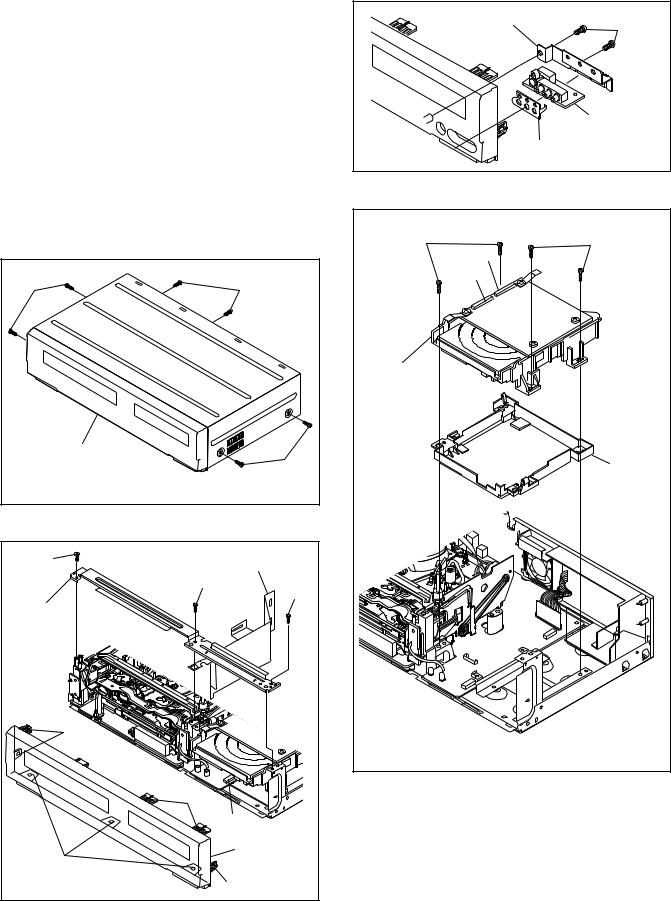
Reference Notes
CAUTION 1: Locking Tabs (L-1) and (L-2) are fragile. Be careful not to break them.
1-1. Release five Locking Tabs (L-1). 1-2. Release three Locking Tabs (L-2)
1-3. Disconnect Connector (CN1609), and remove the Front Assembly.
2.When reassembling, solder wire jumpers as shown in Fig. D8.
3.Before installing the Deck Assembly, be sure to place the pin of LD-SW on Main CBA as shown in Fig. D8. Then, install the Deck Assembly while aligning the hole of Cam Gear with the pin of LDSW, the shaft of Cam Gear with the hole of LD-SW as shown in Fig. D8.
(S-1) |
(S-1) |
[1] Top Cover |
|
|
(S-1) |
|
Fig. D1 |
(S-2) |
[4] Radiation Sheet |
|
|
||
|
(S-2) |
(S-3) |
|
|
|
[3] Front |
|
|
Bracket |
|
|
(L-1) |
|
|
|
(L-1) |
|
|
CN1609 |
|
|
[2] Front |
|
(L-2) |
Assembly |
|
|
|
|
|
(L-1) |
Fig. D2 |
|
|
1-6-2 |
[5] Jack Bracket |
(S-4) |
[6] Jack CBA |
Jack Earth Plate |
Fig. D3 |
(S-5A) |
(S-5B) |
|
CN101 |
|
CN701 |
[7] DVD Mechanism
&
DVD Main CBA Assembly
[8] Dust Cover
Fig. D4
E9AB1DC
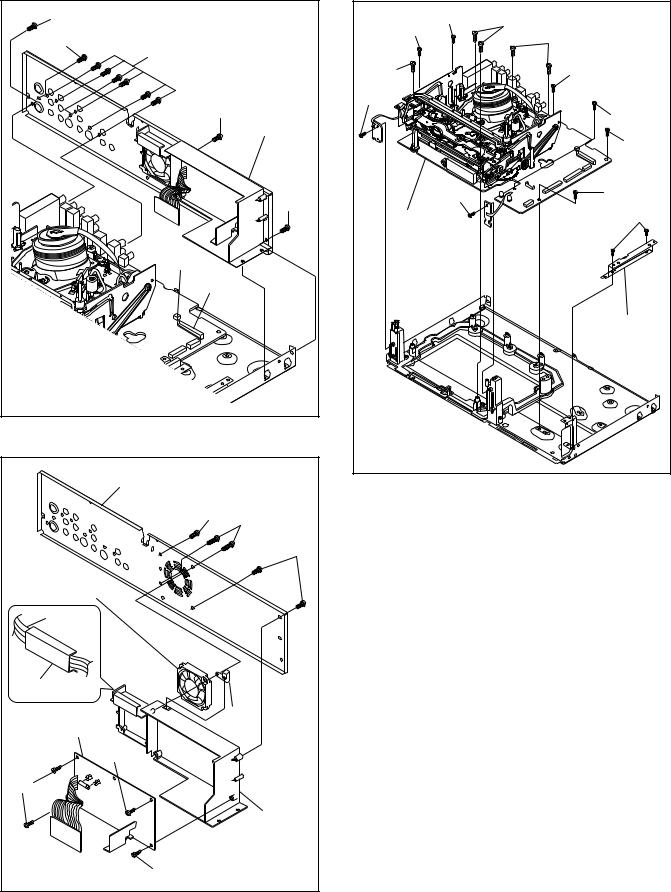
(S-7) |
|
(S-8) |
|
(S-6) |
|
(S-7) |
[9] Rear |
|
Panel Unit |
|
(S-7) |
CN102 |
|
CN101 |
|
|
Fig. D5 |
|
[13] Rear Panel |
|
(S-11) (S-10) |
|
(S-11) |
[11] DC Fan Motor |
|
AC Cord |
|
Hook |
|
[10] Power |
Earth |
Supply CBA |
Plate |
|
(S-9) |
(S-9) |
|
|
[12] PCB |
|
Holder |
|
(S-9) |
|
Fig. D6 |
(S-14) |
(S-13) |
|
(S-14) |
||
(S-13) |
||
|
||
(S-13) |
(S-14) |
|
(S-15) |
|
|
|
(S-14) |
|
|
(S-14) |
|
(S-16) |
(S-14) |
|
|
||
[15] VCR |
(S-12) |
|
Chassis |
|
|
Unit |
|
|
|
[14] Bracket R |
|
|
Fig. D7 |
1-6-3 |
E9AB1DC |
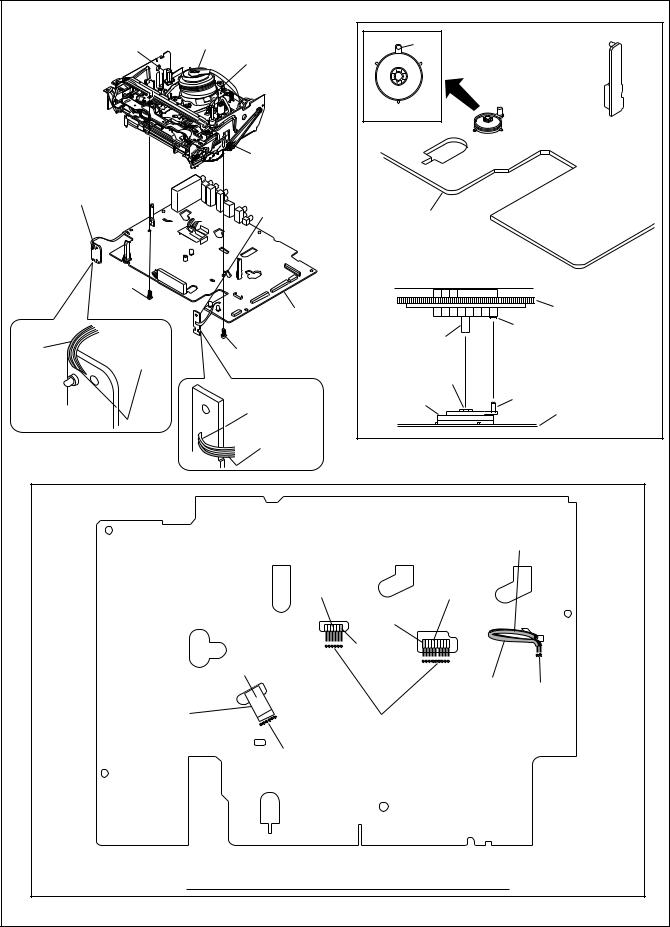
|
|
Cylinder |
|
|
|
|
FE Head |
Assembly |
|
Pin |
|
|
ACE Head |
|
|
|
|
|
|
|
|
|
|
|
|
Assembly |
|
|
|
|
|
|
|
|
SW512 |
|
|
|
|
|
LD-SW |
|
|
[16] Deck |
|
|
|
|
[17] Power |
Assembly |
|
|
|
|
[18] DVD Open |
|
|
|
|
|
SW CBA |
|
|
|
|
|
/Close SW CBA |
|
|
||
|
|
[19] Main CBA |
|
||
|
|
|
|
|
|
|
(S-17) |
|
|
[16] Deck Assembly |
|
|
|
|
|
|
|
|
|
[19] Main |
|
|
Cam Gear |
|
|
|
|
Hole |
|
Lead |
|
CBA |
|
Shaft |
|
with |
|
|
|
|
|
|
(S-18) |
|
|
|
|
blue |
|
|
|
|
|
Desolder |
|
|
|
||
stripe |
|
|
|
Hole |
|
|
|
|
|
|
|
|
|
|
|
LD-SW |
Pin |
|
|
Desolder |
|
|
[19] Main CBA |
|
|
Lead with |
|
|
|
|
|
blue stripe |
|
|
|
|
|
|
|
From |
|
|
|
|
|
FE Head |
|
|
|
From |
|
From |
|
|
|
ACE Head |
Cylinder |
|
|
|
|
Assembly |
|
Assembly |
|
|
|
|
|
Lead with |
|
|
|
|
|
blue stripe |
|
|
|
|
Lead with |
|
|
|
|
Printing side |
blue stripe |
|
|
|
|
|
|
|
|
|
|
|
|
Lead with |
Desolder |
|
|
From |
|
gray stripe |
|
|
|
|
|
||
|
|
Capstan |
|
Desolder |
|
|
|
Motor |
|
|
|
|
|
|
|
|
|
|
|
Assembly |
|
|
|
|
|
Desolder |
|
|
|
|
|
BOTTOM VIEW |
|
||
|
|
Lead connections of Deck Assembly and Main CBA |
|
||
|
|
|
|
|
Fig. D8 |
|
|
1-6-4 |
|
|
E9AB1DC |
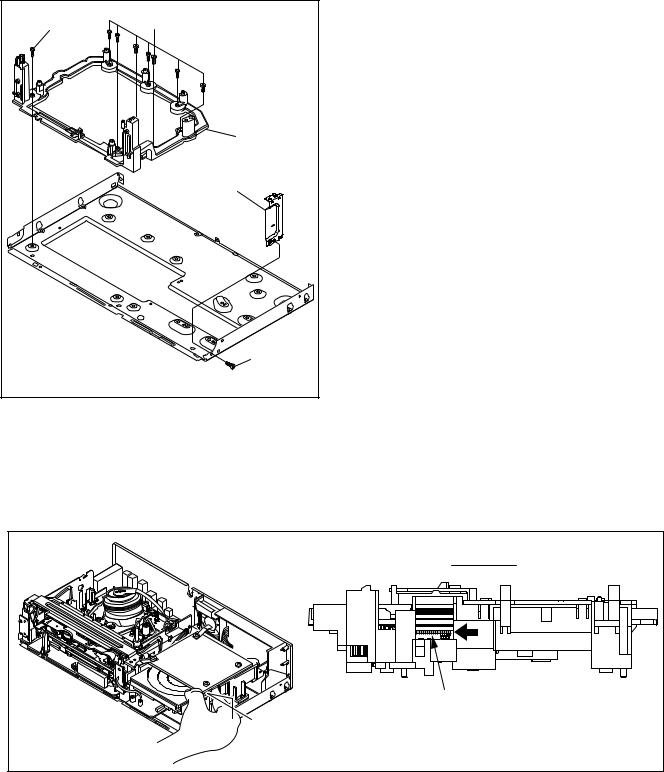
(S-19) |
(S-19) |
|
[20] Deck |
|
Pedestal |
|
[21] Front |
|
Bracket R |
|
(S-20) |
|
Fig. D9 |
3. How to Eject Manually
Note: When rotating the gear, be careful not to damage the gear.
1.Remove the Top Cover.
2.Rotate the gear in the direction of the arrow manually as shown below until the tray descends.
3.Pull the tray out manually and remove a disc.
|
View for A |
|
Rotate this gear in |
A |
the direction of the arrow |
|
1-6-5 |
E9AB1DC |
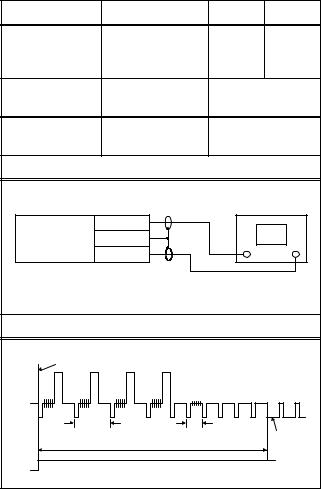
ELECTRICAL ADJUSTMENT INSTRUCTIONS
General Note: “CBA” is abbreviation for “Circuit Board Assembly.”
NOTE:
1.Electrical adjustments are required after replacing circuit components and certain mechanical parts. It is important to do these adjustments only after all repairs and replacements have been completed. Also, do not attempt these adjustments unless the proper equipment is available.
2.To perform these alignment / confirmation procedures, make sure that the tracking control is set in the center position: Press either [CHANNEL L] or [CHANNEL K] button on the front panel first, then the [PLAY] button on the front panel.
Test Equipment Required
1.Oscilloscope: Dual-trace with 10:1 probe, V-Range: 0.001~50 V/Div.,
F-Range: DC~AC-20 MHz
2.Alignment Tape (FL8A)
Head Switching Position
Adjustment
Purpose: To determine the Head Switching position during playback.
Symptom of Misadjustment: May cause Head Switching noise or vertical jitter in the picture.
Test point |
Adj. Point |
Mode |
Input |
||
TP751(V-OUT) |
VR501 |
PLAY |
|
||
TP302(RF-SW) |
----- |
||||
(Switching Point) |
(SP) |
||||
GND |
|
|
|
|
|
Tape |
|
Measurement |
Spec. |
||
|
Equipment |
||||
|
|
|
|
||
FL8A |
|
Oscilloscope |
6.5H ± 1H |
||
|
(412.7 s±63.5 s) |
||||
|
|
|
|||
Connections of Measurement Equipment |
|||||
|
|
|
Oscilloscope |
||
|
TP751 |
|
|
||
Main CBA |
|
GND |
|
|
|
|
TP302 |
|
|
||
|
|
|
CH1 |
CH2 |
|
|
|
|
Trig. (+) |
||
|
|
Figure 1 |
|
|
|
EXT. Syncronize Trigger Point |
|
||||
CH1 |
1.0H |
|
0.5H |
|
|
|
|
V-Sync |
|||
CH2 |
6.5H±1H (412.7 s±63.5 s) |
||||
|
|||||
|
|
|
|
||
|
|
Switching Pulse |
|
|
|
Note: TP751(V-OUT), TP302(RF-SW),
VR501(Switching Point) --- Main CBA
Reference Notes:
Playback the Alignment tape and adjust VR501 so that the V-sync front edge of the CH1 video output waveform is at the 6.5H ± 1H (412.7 s ± 63.5 s) delayed position from the rising edge of the CH2 head switching pulse waveform.
1-7-1 |
H9801EA |
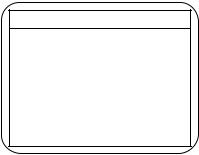
HOW TO INITIALIZE THE DVD RECORDER & VCR
To put the program back at the factory-default, initialize the DVD recorder & VCR as the following procedure.
< DVD Section >
1.Turn the DVD recorder on.
2.Confirm that no disc is loaded or that the disc tray is open. To put the DVD recorder into the Version display mode, press [DVD], [CM SKIP], [1], [2], and [3] buttons on the remote control in that order. Fig. a appears on the screen.
*1: "*******" differs depending on the models. *2: Firmware Version differs depending on the
models, and this indication is one example.
F/W VERSION DISP
MODEL NAME : |
******* |
FE VERSION : |
R30_005_082 |
BE VERSION : |
R3F10210S1E |
TT VERSION : |
T30015FSU |
LD ADJUSTMENT : |
OK |
DISC ADJUSTMENT : |
OK |
DEFAULT SETTING : ENTER
EXIT : RETURN
Fig. a Version Display Mode Screen
3.Press [OK] button, then the DVD recorder starts initializing. When the initializing is completed, the DVD recorder exits the Version display mode and turns off the power automatically.
*To move into the Normal mode from the Version display mode, press [RETURN] button on the remote control instead of [OK] button.
*When [STANDBY-ON] button is pressed before [OK] button is pressed, the DVD recorder exits the Version display mode, then the power turns off.
1-8-1 |
E9A80INT |

FIRMWARE RENEWAL MODE
1.Turn the power on and remove the disc on the tray.
2.To put the DVD recorder into version up mode, press [DVD], [CM SKIP], [6], [5], and [4] buttons on the remote control unit in the order. Then the tray will open automatically.
Fig. a appears on the screen.
*Firmware Version differs depending on the models, and this indication is one example.
Firm Update Mode |
ver. R3F10210S1E |
|
Current |
|
|||
|
|
|
F/W version |
|
|
|
is displayed. |
Please insert a disc.
4.Select the firmware version pressing arrow buttons, then press [OK].
Fig. d appears on the screen. The DVD recorder starts updating.
*Firmware Version differs depending on the models, and this indication is one example.
|
|
|
|
Firm Update Mode |
ver. R3F10210S1E |
Selected |
|
R3F10210S1E |
|
||
|
|
||||
F/W version |
|
|
|
||
is displayed. |
|
|
|
||
(*1) |
|
|
|
File Loading... |
|
|
|
|
|
||
Fig. a Version Up Mode Screen
3.Load the disc for version up.
Fig. c appears on the screen. The file on the top is highlighted as the default.
When there is only one file to exist, Step 4 will start automatically.
*Firmware Version differs depending on the models, and this indication is one example.
Firm Update Mode |
ver. R3F10210S1E |
Disc name VOL_200512250934 is displayed.
1 |
R3F10210S1E |
|
|
|
|
2 |
R3F10211S1E |
|
|
Files included |
|
3 |
R3F10212S1E |
|
|
||
|
|
in the disc are |
|||
4 |
R3F10213S1E |
|
|
||
|
|
|
|
|
displayed. |
1 / 1
Fig. c Update Disc Screen
Fig. d Programming Mode Screen
The appearance shown in (*1) of Fig. d is described as follows.
No. |
Appearance |
State |
|
|
|
|
|
|
|
|
|
1 |
File Loading... |
Sending files into the memory |
|
|
|
|
|
|
Firmware |
|
|
2 |
Updating... |
Writing new version data |
|
|
XX% Complete. |
|
|
|
|
|
|
--- |
Firmware |
Failed in updating |
|
Update Failure |
|||
|
|
||
|
|
|
5.After updating is finished, the tray opens automatically.
At this time, no button is available.
6.Pull out the AC code once, then insert it again.
1-9-1 |
E9AB0FW |

FUNCTION INDICATOR SYMBOLS
< VCR Section >
Note:
If a mechanical malfunction occurs, the power is turned off. When the power comes on again after that by pressing [STANDBY-ON] button, an error message is displayed on the TV screen for 5 seconds.
Led Mode |
Indicator Active |
|
|
|
|
When reel or capstan mechanism is not |
“A R” is displayed on a TV screen. (Refer to Fig. 1.) |
functioning correctly |
|
|
|
When tape loading mechanism is not |
“A T” is displayed on a TV screen. (Refer to Fig. 2.) |
functioning correctly |
|
|
|
When cassette loading mechanism is not |
“A C” is displayed on a TV screen. (Refer to Fig. 3.) |
functioning correctly |
|
|
|
When the drum is not working properly |
“A D” is displayed on a TV screen. (Refer to Fig. 4.) |
|
|
P-ON+5V Power safety detection |
“A P” is displayed on a TV screen. (Refer to Fig. 5.) |
|
|
TV screen
When reel or capstan mechanism is not functioning |
When the drum is not working properly |
correctly |
|
A R
SP 0:00:00
Fig. 1
When tape loading mechanism is not functioning correctly
A D
SP 0:00:00
Fig. 4
P-ON+5V Power safety detection
A T |
|
A P |
|
SP |
0:00:00 |
SP |
0:00:00 |
|
Fig. 2 |
|
Fig. 5 |
When cassette loading mechanism is not functioning correctly
A C
SP 0:00:00
Fig. 3
1-10-1 |
E9A12FIS |
< DVD Section >
Note: If an error occurs, a message with the error number appears on the screen.
|
|
|
|
|
|
|
|
Recording Error |
|
|
|
|
|
|
|
|
|
|
|
Error message |
You cannot record on this disc as |
|
|
|
|||
|
|
|
||||
|
Power Calibration Area is full. |
|
|
|
||
|
E35 |
|
|
Error No. |
||
|
|
|||||
|
|
|
|
|
|
|
Message |
Solution |
Error |
Error Description |
Priority |
|
No. |
|||||
|
|
|
|
||
|
|
|
|
|
|
|
|
1 |
An error occurs during data reading. |
- |
|
|
|
|
|
|
|
|
|
2 |
There is no reply for 15 seconds in Test |
- |
|
|
|
Unit Ready. |
|||
|
|
|
|
||
|
|
|
|
|
|
|
|
3 |
Cannot write the data after trying three |
- |
|
|
|
times. |
|||
|
|
|
|
||
|
|
|
|
|
|
|
|
4 |
An error occurs with OPC. |
- |
|
|
|
|
|
|
|
|
|
5 |
During recovery in a record. |
- |
|
|
|
|
|
|
|
|
|
6 |
An error occurs even if recovery has been |
- |
|
|
|
tried three times. |
|||
|
|
|
|
||
|
|
|
|
|
|
|
|
7 |
An error occurs in a format. |
- |
|
|
|
|
|
|
|
|
|
8 |
It cannot start an encode. |
- |
|
|
|
|
|
|
|
|
|
9 |
NV_PCK/RDI_PCK is not in encoded |
- |
|
|
|
data. |
|||
|
|
|
|
||
|
|
|
|
|
|
|
|
10 |
Encode Pause condition continued for 10 |
- |
|
|
|
minutes. |
|||
|
|
|
|
||
|
|
|
|
|
|
|
Insert the recordable disc, and |
11 |
Encode Pause condition continued in |
- |
|
|
normal REC condition for 10 minutes. |
||||
Can not record on this disc. |
ensure the disc status satisfies |
|
|
||
|
|
|
|||
|
the recording requirements. |
12 |
Difference in the address and can not get |
- |
|
|
|
StreamID of RDI/VIDEO. |
|||
|
|
|
|
||
|
|
|
|
|
|
|
|
13 |
It is a reply that “ATAPI is not readable.” |
- |
|
|
|
|
|
|
|
|
|
14 |
Cannot write the data after recovering |
- |
|
|
|
SMALL VMGI. |
|||
|
|
|
|
||
|
|
|
|
|
|
|
|
15 |
Cannot write the data after DVD-R |
- |
|
|
|
Reverse Track. |
|||
|
|
|
|
||
|
|
|
|
|
|
|
|
16 |
An error occurs in Finalize Close. |
- |
|
|
|
|
|
|
|
|
|
17 |
An error occurs in Rec Stop Close. |
- |
|
|
|
|
|
|
|
|
|
18 |
An error occurs in PCA Full (DVD_R). |
- |
|
|
|
|
|
|
|
|
|
19 |
Safety Stop occurs during editing. |
- |
|
|
|
|
|
|
|
|
|
20 |
High Speed Disc. |
2 |
|
|
|
|
|
|
|
|
|
21 |
The disc is not formatted. |
5 |
|
|
|
|
|
|
|
|
|
22 |
Disc Error has occurred. |
3 |
|
|
|
|
|
|
|
|
|
24 |
The disc except DVD-R/RW or finalized |
1 |
|
|
|
DVD-R. |
|||
|
|
|
|
||
|
|
|
|
|
|
This program is not allowed to |
You cannot record copy |
25 |
During the Macrovision picture input. |
11 |
|
be recorded. |
prohibited programs. |
26 |
During the CGMS picture input. |
12 |
|
|
|
||||
|
|
|
|
|
|
This disc is protected and not |
Release the disc protect |
|
|
|
|
setting in the Disc Setting |
29 |
Disc Protected Disc. |
7 |
||
recordable. |
|||||
menu. |
|
|
|
||
|
|
|
|
||
|
|
|
|
|
1-10-2 |
E9A12FIS |
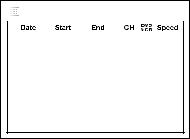
Message |
Solution |
Error |
Error Description |
Priority |
|
No. |
|||||
|
|
|
|
||
|
|
|
|
|
|
Disc is full. |
Insert the recordable disc with |
30 |
No avilable recording space. |
5 |
|
(No area for new recording) |
enough recording space. |
||||
|
|
|
|||
|
|
|
|
|
|
You cannot record on the disc |
|
|
|
|
|
as Power Calibration Area is |
Insert a new disc. |
35 |
PCA is Full. (in REC start) |
4 |
|
full. |
|
|
|
|
|
|
|
|
|
|
|
This disc is already finalized. |
Release the finalizing for this |
36 |
It is finalized. (Video Format Disc) |
6 |
|
disc. |
|||||
|
|
|
|
||
|
|
|
|
|
|
|
|
37 |
Access to Memory Area range outside. |
- |
|
|
|
|
|
|
|
Can not record on this disc. |
Repeat the same operation. |
38 |
Sector Address is wrong. |
- |
|
|
|
|
|
|
|
|
|
39 |
BUP writing error of chapter editing. |
- |
|
|
|
|
|
|
|
You cannot record more than |
|
|
|
|
|
49 titles on the disc.(The |
Delete unnecessary titles. |
43 |
Its recording capacity has been reached. |
9 |
|
maximum is 49.) |
|
|
|
|
|
|
|
|
|
|
|
You cannot record more than |
Delete unnecessary chapter |
|
|
|
|
254 chapters on the disc.(The |
44 |
The 254 chapter has been reached. |
10 |
||
marks. |
|||||
maximum is 254.) |
|
|
|
||
|
|
|
|
||
|
|
|
|
|
|
This program is not recordable |
You cannot record copy |
45 |
During the CGMS picture input. |
12 |
|
in +VR mode. |
prohibited programs. |
||||
|
|
|
|||
|
|
|
|
|
|
The disc has a different menu |
Set “Replace Disc Menu” to |
|
Trying to record onto the +VR formatting |
|
|
layout. (Set “Replace Disc |
|
|
|||
“ON” to rewrite the menu,after |
46 |
disc that had been recorded by the other |
7 |
||
Menu” to ON to rewrite the |
|||||
that you will record to. |
|
recorder. |
|
||
menu.) |
|
|
|||
|
|
|
|
||
|
|
|
|
|
If an error occurs during the timer recording, one of the following error numbers (40 to 42) or the above error messages (error number: 1 to 46) is displayed on the recording menu after timer recording.
(Once the timer programming list with error indication is displayed, the program line(s) with error will be cleared only after the programs are cancelled and reset to the timer standby mode.)
(In the case of the error occurs during setting the timer programming, no error messages is displayed.)
|
Timer Programming |
|
|
|
|
|
|
|
|
|
|
|
|
|
VCR |
|
DVD |
|
|
|
|||
|
|
|
|
|
|
|
|
|
|
|
|
|
|
|
|
|
|
|
|
|
|
|
|
* JAN/01 12:57AM |
|
|
|
|
|
|
|
|
|
The speed mode changes |
|
1:57AM 8 DVD E40 |
|
|
|||||||||
|
|
||||||||||
2. --- |
|
|
|
|
|
|
|
|
|
to the error number. |
|
|
|
|
|
|
|
|
|
|
|
|
|
3.---
4.---
5.---
6.---
7.---
8.---
A program with the error number is grayed out and asterisked on the timer programming list.
Message |
Solution |
Error |
Error Description |
Priority |
|
No. |
|||||
|
|
|
|
||
|
|
|
|
|
|
|
|
|
|
|
|
|
- Set the timer programming |
|
- Some portion has not been recorded |
|
|
|
correctly. |
|
|
||
|
|
because of program overlapping. |
|
||
|
- Set the timer programming |
|
|
||
|
40 |
- Recording did not start at the start time. |
- |
||
|
before the start time. |
||||
|
|
- No Videotape is inserted. |
|
||
Error message is not |
- Insert a recordable videotape |
|
|
||
|
Videotape ran out during recording. |
|
|||
with a record tab. |
|
|
|||
displayed. |
|
|
|
||
|
|
|
|
||
|
Turn the power on and set the |
|
|
|
|
|
clock correctly then set timer |
41 |
Power failed |
- |
|
|
programming again. |
|
|
|
|
|
|
|
|
|
|
|
Insert the recordable disc. |
42 |
No disc when recording |
- |
|
|
|
|
|
|
1-10-3 |
E9A12FIS |
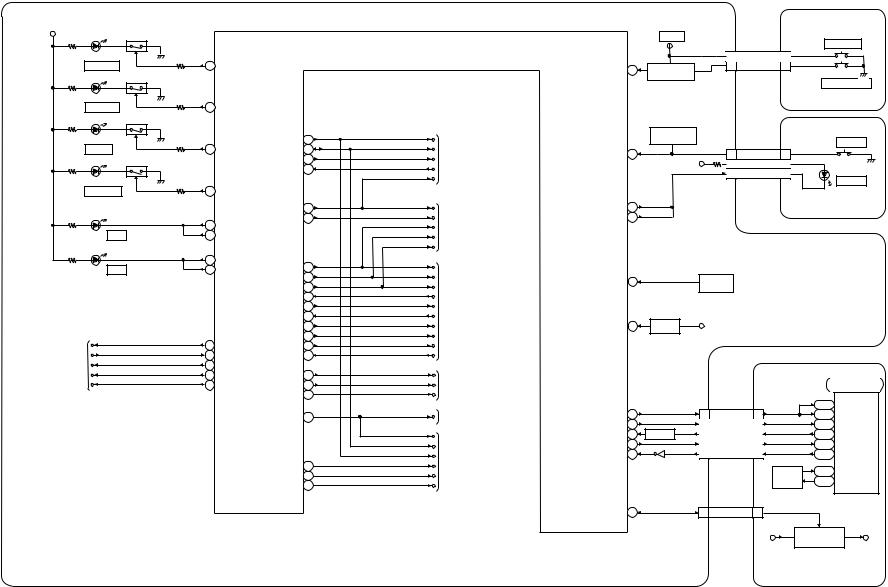
1-11-1
E9AB1BLS
IC501
AL+5V |
(SYSTEM CONTROL) |
|
TP502 |
|
|
|
|
Q512 |
|
S-INH |
|
|
SW617 |
|
|
|
|
DUBBING |
||
|
|
|
|
CN2209 |
CN2210 |
|
|
|
|
|
|
||
D565 |
|
|
|
1 DUBBING-SW |
1 |
|
DVD-REC |
63 DVD-REC-LED |
85 |
KEY SWITCH |
2 OPEN/CLOSE-SW 2 |
|
|
|
KEY- 2 |
|
|
SW615 |
||
|
Q513 |
|
(DVD) |
|
|
|
|
|
|
|
OPEN/CLOSE |
||
|
|
|
|
|
||
|
|
|
|
|
|
|
D566 |
DVD OPEN/CLOSE |
VCR-REC |
SW CBA |
64 VCR-REC-LED |
|
|
Q514 |
|
D577 |
|
|
IIC-BUS SCL 18 |
|
|
TIMER |
|
66 TIMER-LED |
IIC-BUS SDA 17 |
|
|
|
Q511 |
|
Hi-Fi-H-SW 30 |
|
|
|
|
Hi-Fi/NOR-IN 78 |
||
|
|
|
|
||
|
D502 |
|
|
|
|
|
DUBBING |
14 DUBBING-LED |
|||
|
|
|
VCR-AUDIO-MUTE 31 |
||
|
|
|
94 VCR-LED |
D-REC 29 |
|
|
|
|
|
||
|
D563 |
VCR |
95 VCR-LED |
|
|
|
|
|
96 DVD-LED |
YCA-SCL 19 |
|
|
D562 |
DVD |
97 DVD-LED |
||
|
YCA-SDA 20 |
||||
|
|
|
|
||
|
|
|
|
YCA-CS 21 |
|
|
|
|
|
C-SYNC-IN 50 |
|
|
|
|
|
D-V SYNC 24 |
|
|
|
|
|
V-ENV 83 |
|
|
|
|
|
C-ROTA 98 |
|
|
REG-CONT1 |
|
RF-SW 23 |
||
|
46 REG-CONT1 |
H-A-SW 99 |
|||
|
P-DOWN-H |
||||
|
1 P-DOWN-H |
H-A-COMP 100 |
|||
TO POWER SUPPLY |
P-ON-L |
||||
27 P-ON-L |
|
||||
|
|
|
|||
BLOCK DIAGRAM |
PWR-SW |
|
|||
43 PWR-SW |
VIDEO-SW1 59 |
||||
|
FAN-CONT1 |
||||
|
91 FAN-CONT1 |
VIDEO-SW2 58 |
|||
|
|
|
|||
VIDEO-SW3 57 
OUTPUT-SELECT 55 
AUDIO-SW1 61 
AUDIO-SW2 60 
DVD-AUDIO-MUTE 56 
IIC-BUS SCL |
|
KEY SWITCH |
|
|
|
SW601 |
|
(VCR) |
|
|
|
POWER |
|
IIC-BUS SDA |
|
CN2211 |
|
CN2212 |
||
|
|
|
||||
TO Hi-Fi AUDIO |
|
|
|
|||
Hi-Fi-H-SW |
KEY- 1 86 |
4 |
POWER-SW |
4 |
|
|
BLOCK |
|
|||||
NORMAL-L |
AL+5V |
1 |
AL+5V |
1 |
|
|
DIAGRAM |
D561 |
|||||
AUDIO-MUTE |
|
|
2 |
POWER-LED |
2 |
|
|
|
POWER |
||||
|
|
|
|
|
|
AUDIO-MUTE |
POWER-LED 92 |
POWER SW CBA |
|
D-REC |
|||
POWER-LED 93 |
|
||
YCA-SCL |
|
||
TO AUDIO |
|
||
YCA-SDA |
BLOCK DIAGRAM |
|
|
|
|
||
YCA-CS |
|
|
|
YCA-SCL |
|
RS501 |
|
YCA-SDA |
|
||
|
REMOTE |
||
YCA-CS |
REMOTE-VIDEO 5 |
||
SENSOR |
|||
C-SYNC |
|
||
|
|
||
D-V SYNC |
|
|
V-ENV |
TO VIDEO |
Q501 |
|
BLOCK DIAGRAM |
|||
|
C-ROTA
RESET 25 RESET TIMER+5V
RF-SW
H-A-SW
H-A-COMP
VIDEO-SW1
VIDEO-SW2
VIDEO-SW3
OUTPUT-SELECT
OUTPUT-SELECT
IIC-BUS SDA
IIC-BUS SCL
AUDIO-SW1
AUDIO-SW2
DVD-AUDIO-MUTE
TO VIDEO INPUT SELECT BLOCK DIAGRAM
TO VIDEO OUTPUT SELECT BLOCK DIAGRAM
TO AUDIO INPUT/OUTPUT SELECT BLOCK DIAGRAM
|
|
|
|
|
|
|
IC101 |
|
|
|
|
|
|
|
|
MAIN MICRO |
|
|
|
|
|
|
|
|
CONTROLLER |
|
|
CN201 |
|
CN701 |
|
T4 |
SYS-RESET |
||
SYS-RESET 44 |
|
4 |
SYS-RESET |
4 |
|
J25 |
SYS-RESET |
|
S-DATA-OUT 13 |
BUFFER Q510 |
3 |
SUB-TXD |
3 |
|
N24 |
SUB-TXD |
|
S-DATA-IN 12 |
1 |
SUB-RXD |
1 |
|
N23 |
SUB-RXD |
||
S-CLK 11 |
|
5 |
SUB-SCLK |
5 |
|
L25 |
SUB-SCLK |
|
READY/BUSY 2 |
|
2 |
RDY |
2 |
|
R24 |
RDY |
|
|
Q509 |
|
|
X552 |
|
|
|
|
|
|
|
|
27MHZ |
N2 |
CLK27 IN |
||
|
|
|
|
N1 |
CLK27 OUT |
|||
|
|
|
|
X'TAL |
||||
|
CN2204 |
|
CN101 |
|
|
|
|
|
REG-CONT2 45 |
|
30 REG-CONT2 30 |
|
|
|
|
||
|
|
|
|
|
IC106 |
|
|
|
|
|
|
|
|
+1.2V |
|
|
|
|
|
|
|
EV+2.4V |
REGULATOR |
P-ON+1.2V |
||
|
|
|
|
|
|
|
||
MAIN CBA |
DVD MAIN CBA |
DIAGRAMS BLOCK
Diagram Block Control System
